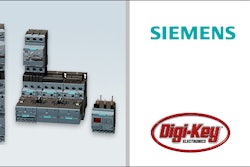
The energy-efficiency regulatory update scheduled for 2023 will affect builders of HVAC equipment, industrial fans, cooling towers and pumps, including those used in irrigation systems. The new standard has many OEMs considering a switch from induction motors to variable frequency drives (VFDs) combined with permanent magnet motors.
An interior permanent magnet motor, or IPM, is a synchronous motor with permanent magnets embedded inside. It’s more energy efficient than a standard induction motor because there’s no current flow to the rotor (secondary side) and no secondary copper loss. Magnetic flux is generated with permanent magnets, and so less motor current is required. In addition, the embedded magnets provide reluctance torque, which can also be applied to a machine’s power system.
Mitsubishi Electric’s FR-E800, FR-F800 and FR-A800 drives can work with either induction or permanent magnet motors, according to Chris Rhodes, product marketing manager. “This flexibility means machine builders won’t have to change their control panels, just the motor, if they decide to move from induction to permanent magnet motors. It will just be a matter of phase-in, phase out, so OEMs can move at their own pace.”
One advantage of the new FR-E800 drives is their ability to auto-tune both induction and PM motors. The drives will be available for 200-, 400- and 600-volt applications. The tuning function is controlled by software parameters for values such as RPM, speed, frequency, full load and current voltage.
“OEM engineers need only input key information from the motor nameplate into the parameters of the drive and push auto-tune,” says Rhodes. “There may be minor tweaking required, but basically you’re ready to go. It’s a major time-saver for engineers.”
This auto-tuning function gives a VFD’s vector control algorithm better than stock parameters to control the motor flux and, ultimately, the output torque performance of a motor. The new Mitsubishi Electric drives also enable operation of other manufacturers’ induction and PM motors, which will likely help increase the use of PM motors in applications that require reduced energy consumption.
“Machine builders typically use the same motor in different machines, so auto-tuning is a simple matter of replication,” he adds. “Once you set it, you’re done, regardless of the motor count.
“While VFDs make motorized systems run more efficiently, whether the type of motor is induction, permanent magnet or synchronous reluctance, OEMs in critical applications need to explore solutions to mitigate harmonics, filter out line noise and minimize the impact on the power grid,” says Rhodes. “At Mitsubishi Electric, we have many VFD filter options to deal with these issues.”




















